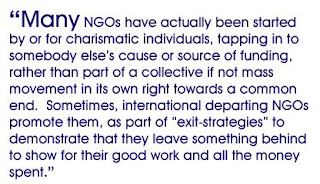The Name of the Game is “Sustainability”
but Does the Last Player Count?
An Article by John Lowrie
Today, it is obligatory to answer the question “how will your proposed activities be sustainable after the project?” Most of us dutifully play the game and repeat various sentences that describe the measures that “should” bring sustainability about. Then it is usually left at that. We all move on to the next project and donor. Seldom does anyone look back over the passing of many years to check to see if promise has turned in to reality. At best there may be an end-project evaluation which will say that planned outcomes are achieved and “likely” to be sustained. It would be a very brave evaluator to be more committed beyond that.
My question is why do we play this game? (I should add: apart from the obvious answer we need the donors’ money!) Sustainability is much more than a ruse in a game. It goes to the very essence of what kind of organisation we belong to; plus all the others with us whether staff, supporters or beneficiaries; how we originated and what are our real long-term plans?
Many NGOs are artificially created groupings of people, unlike the first ones last century that emerged as people on a mission to address specific issues that they felt strongly about. Latterly, NGOs are now lumped in to “Civil Society” which is another recent fashionable label in development jargon. This is despite many officials and even NGO workers in Cambodia having no idea that it is supposed to encompass more than NGOs, to embrace other groups such as the press, trade unions, etc. Many NGOs have actually been started by or for charismatic individuals, tapping in to somebody else’s cause or source of funding, rather than part of a collective if not mass movement in its own right towards a common end. Sometimes, international departing NGOs promote them, as part of “exit-strategies” to demonstrate that they leave something behind to show for their good work and all the money spent. They may have even included a plan for it in their sustainability proposal write-up. In Cambodia the “gravy train” that accompanied UNTAC, the massive international effort to bring lasting peace and democracy in the early 90s, spawned many. Some of these NGOs have been good and stood the test of time. Many have fallen by the wayside. Others have been co-opted by political interests. Few have proper accountable self-governance structures.
So how can they be really sustainable? What is driving them – apart that is from the obvious – money? It is true that many do good work. They often do work that local authorities should be  doing. But, I ask, towards what end? For example “poverty alleviation” is not an end in itself; for it to be sustained it needs much more than the usual 1-3 year time-frames that donors favour for their projects. Yet the usual pattern is – identify your target groups, go there, pass on whatever to them, then move on (to the next ones). There are exceptions. Lutheran World Federation (LWF) expect to work for 10 or more years in their target communities before they “graduate” and begin a systematic staged withdrawal. Mostly, however, the projects end on time or soon after, the files are closed, and that is that, at least until next time.
doing. But, I ask, towards what end? For example “poverty alleviation” is not an end in itself; for it to be sustained it needs much more than the usual 1-3 year time-frames that donors favour for their projects. Yet the usual pattern is – identify your target groups, go there, pass on whatever to them, then move on (to the next ones). There are exceptions. Lutheran World Federation (LWF) expect to work for 10 or more years in their target communities before they “graduate” and begin a systematic staged withdrawal. Mostly, however, the projects end on time or soon after, the files are closed, and that is that, at least until next time.


